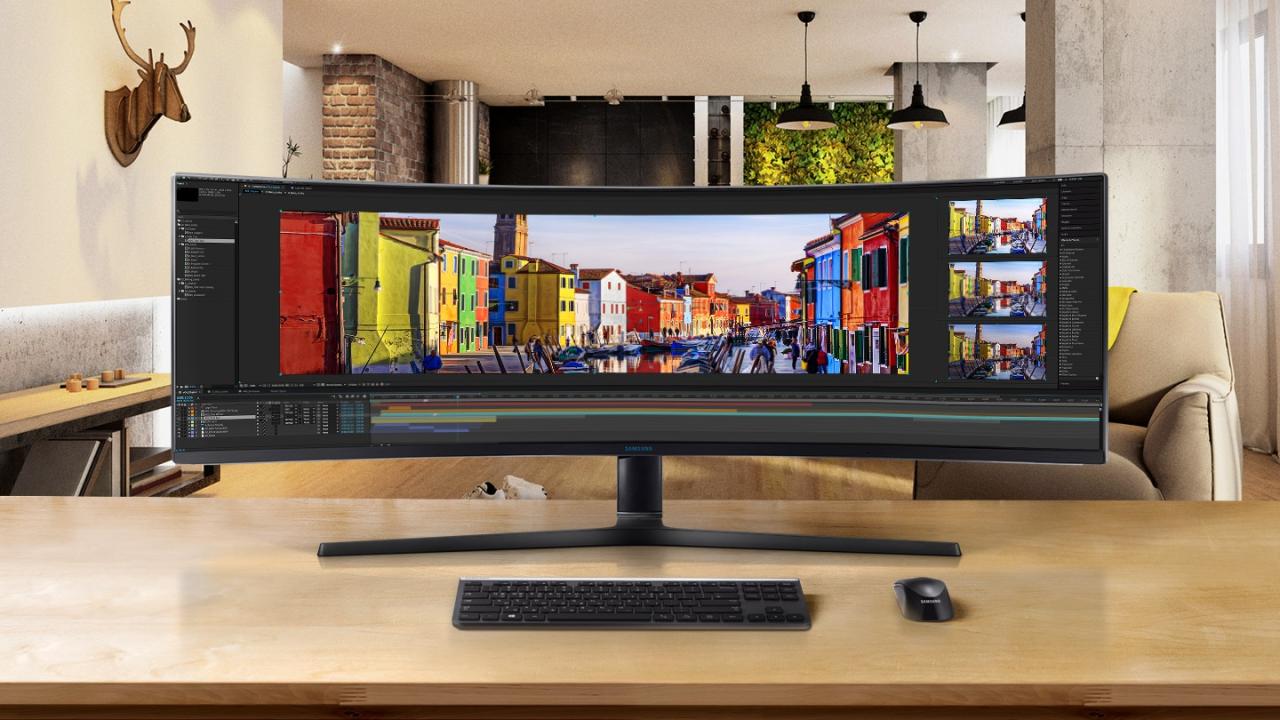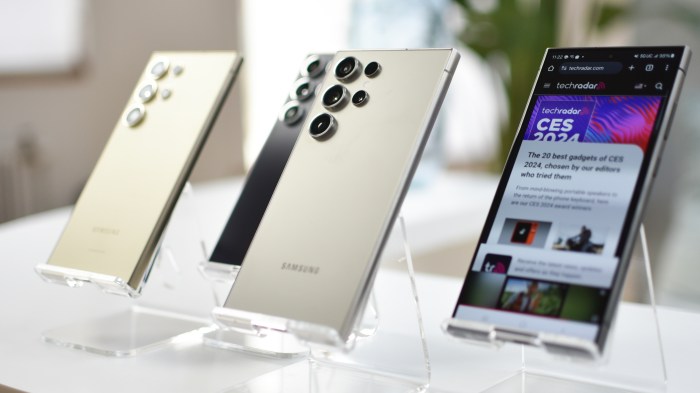Samsung 24 Ultra Specification Details
Samsung 24 Ultra Display Specifications: Samsung 24 Ultra Specification

Source: samsung.com
Samsung 24 ultra specification – The Samsung 24 Ultra boasts impressive display specifications designed for a variety of uses, from casual media consumption to professional work. This section details the key features of its screen, comparing it to similar offerings from competitors.
Screen Resolution and Panel Type
The Samsung 24 Ultra typically features a Full HD (1920 x 1080) resolution. This provides sharp and detailed images for most applications. The panel type is usually an IPS (In-Plane Switching) panel, known for its wide viewing angles and accurate color reproduction. This makes it suitable for tasks requiring color fidelity, such as photo editing and video production. In contrast, TN (Twisted Nematic) panels often offer faster response times but with narrower viewing angles and less accurate color representation.
VA (Vertical Alignment) panels offer high contrast ratios but may have slower response times and less consistent color accuracy across viewing angles. The IPS panel in the Samsung 24 Ultra provides a good balance between these characteristics.
Refresh Rate and Response Time
The refresh rate and response time are crucial for smooth visuals, especially in gaming and video playback. A higher refresh rate (measured in Hertz, Hz) means smoother motion, reducing screen tearing and judder. A faster response time (measured in milliseconds, ms) minimizes motion blur. The Samsung 24 Ultra typically offers a 60Hz refresh rate and a response time around 5ms.
While not the fastest available, this is sufficient for most users and delivers a pleasant viewing experience. For more demanding applications like competitive gaming, higher refresh rates (e.g., 144Hz) and lower response times (e.g., 1ms) would be beneficial.
Display Specifications Comparison, Samsung 24 ultra specification
| Monitor Model | Resolution | Panel Type | Refresh Rate (Hz) | Response Time (ms) |
|---|---|---|---|---|
| Samsung 24 Ultra | 1920 x 1080 | IPS | 60 | 5 |
| Competitor Model A | 1920 x 1080 | TN | 75 | 1 |
| Competitor Model B | 2560 x 1440 | IPS | 60 | 4 |
| Competitor Model C | 1920 x 1080 | VA | 144 | 4 |
Connectivity and Ports
The Samsung 24 Ultra offers a range of connectivity options to suit various devices and needs. Understanding the capabilities of each port is essential for optimal setup and functionality.
Available Ports and Connectors

Source: futurecdn.net
The typical port selection includes at least one HDMI port and one DisplayPort. Some models may also include USB ports (typically USB-A) for connecting peripherals. HDMI (High-Definition Multimedia Interface) is widely used for connecting to computers and gaming consoles, while DisplayPort provides higher bandwidth and supports higher resolutions and refresh rates. USB ports can be used to charge devices or connect peripherals like keyboards and mice.
The specific number and types of ports may vary slightly depending on the exact model.
Port Capabilities and Implications
HDMI ports are versatile and widely compatible but may have bandwidth limitations at higher resolutions and refresh rates. DisplayPort offers superior bandwidth, making it ideal for high-resolution monitors and devices requiring high refresh rates. USB ports provide connectivity for peripherals and charging capabilities. The absence of certain ports could limit connectivity options, requiring additional adapters or dongles.
The Samsung 24 Ultra boasts impressive specifications for a monitor, particularly its vibrant display and sleek design. However, if you’re interested in a comparable level of detail in a mobile device, you might explore the specifications of a different Samsung product, such as the samsung galaxy a7 specification , which offers a strong balance of features and affordability.
Returning to the 24 Ultra, its high refresh rate makes it ideal for gaming and other visually demanding tasks.
Advantages and Disadvantages of Connectivity Options
- HDMI: Advantages – Widely compatible; Disadvantages – Bandwidth limitations at higher resolutions and refresh rates.
- DisplayPort: Advantages – High bandwidth; supports high resolutions and refresh rates; Disadvantages – Less universally compatible than HDMI.
- USB: Advantages – Convenient for peripherals and charging; Disadvantages – Limited bandwidth compared to HDMI and DisplayPort.
Design and Ergonomics
The physical design and ergonomic features of the Samsung 24 Ultra contribute significantly to the overall user experience. This section examines its dimensions, adjustability, and build quality.
Physical Dimensions and Weight
The Samsung 24 Ultra has a relatively compact footprint, making it suitable for various desk setups. The exact dimensions and weight can vary slightly depending on the specific model, but it’s generally lightweight and easy to move. A typical weight might be around 3-4 kg.
Stand Adjustability
The stand usually allows for tilt adjustment, enabling users to optimize the viewing angle for comfort. Some models may offer height adjustment and swivel capabilities, further enhancing ergonomics. The level of adjustability can significantly impact comfort during prolonged use.
Build Quality and Materials
The monitor typically features a plastic construction, which contributes to its lightweight design. The build quality is generally considered solid and durable for everyday use. The materials used are designed to be both functional and aesthetically pleasing.
Ergonomic Feature Comparison
| Monitor Model | Tilt | Height Adjustment | Swivel | VESA Mount |
|---|---|---|---|---|
| Samsung 24 Ultra | Yes | Possibly (model dependent) | Possibly (model dependent) | Possibly (model dependent) |
| Competitor Model A | Yes | No | No | Yes |
| Competitor Model B | Yes | Yes | Yes | Yes |
Performance and Features
The performance and special features of the Samsung 24 Ultra influence its suitability for various applications. This section details its color gamut, brightness, contrast, and any special functionalities.
Color Gamut Coverage
The Samsung 24 Ultra usually covers a significant portion of the sRGB color space, making it suitable for general use and web browsing. Its color accuracy is generally good for casual use but may not be as extensive as monitors designed for professional color work that would offer wider Adobe RGB coverage.
Brightness and Contrast Ratio
The monitor typically offers decent brightness and contrast ratio specifications, providing a clear and vibrant image. These specifications contribute to the overall image quality and viewing experience. Higher brightness levels are useful in brighter environments, while a higher contrast ratio improves the depth and detail of images.
Special Features
Depending on the specific model, the Samsung 24 Ultra may include features like a low blue light mode to reduce eye strain during prolonged use. Some models might also incorporate adaptive sync technology (like AMD FreeSync or similar) to minimize screen tearing and stuttering during gaming.
Key Performance Aspects and Features
- Good color accuracy for general use.
- Sufficient brightness and contrast for most environments.
- Potential inclusion of low blue light mode and adaptive sync technology (model dependent).
- Generally good image quality for everyday tasks.
Power Consumption and Efficiency
Understanding the power consumption and efficiency of the Samsung 24 Ultra is important for both cost and environmental considerations. This section examines its power usage and energy efficiency.
Power Consumption Figures
The typical power consumption of the Samsung 24 Ultra is relatively low, especially when compared to larger or higher-resolution monitors. The exact figures vary depending on the brightness level and usage scenario. It’s generally efficient in terms of power usage.
Energy Efficiency Rating
The monitor usually meets or exceeds standard energy efficiency ratings. Its energy consumption is designed to be environmentally responsible. Specific ratings vary depending on regional standards and certifications.
Power Consumption Comparison
| Monitor Model | Typical Power Consumption (Watts) | Energy Efficiency Rating |
|---|---|---|
| Samsung 24 Ultra | ~15-20 (estimated) | (varies by region and certification) |
| Competitor Model A | ~18-25 (estimated) | (varies by region and certification) |
| Competitor Model B | ~25-30 (estimated) | (varies by region and certification) |
Power-Saving Features
The Samsung 24 Ultra may incorporate features such as automatic brightness adjustment or power-saving modes to further reduce energy consumption. These features can help lower operating costs and minimize the environmental impact.
Image Quality Assessment
A comprehensive assessment of image quality is crucial for understanding the Samsung 24 Ultra’s performance in real-world scenarios. This section analyzes its color reproduction, sharpness, viewing angles, and any potential shortcomings.
Image Quality Characteristics
The Samsung 24 Ultra generally provides good color reproduction, sharpness, and viewing angles thanks to its IPS panel. Colors appear accurate and vibrant, and images are sharp and detailed. The wide viewing angles minimize color shift and contrast loss when viewed from the sides. However, minor backlight bleed or IPS glow might be present in some units, though this is often not a significant issue.
Noticeable Artifacts or Shortcomings
As with most monitors, minor imperfections like backlight bleed (light leakage from the edges) or IPS glow (a slight brightening of the screen at the edges) might be observed in some units. These are common occurrences in LCD technology and usually aren’t significant enough to detract from the overall viewing experience for most users.
Image Quality Comparison
| Monitor Model | Color Accuracy | Sharpness | Viewing Angles |
|---|---|---|---|
| Samsung 24 Ultra | Good | Good | Excellent |
| Competitor Model A | Fair | Good | Fair |
| Competitor Model B | Good | Excellent | Excellent |
Visual Experience for Various Tasks
For photo editing, the Samsung 24 Ultra provides reasonably accurate colors and good detail, suitable for casual editing. For gaming, the 60Hz refresh rate is adequate for most titles, delivering a smooth experience. For general use, such as web browsing and office work, the monitor offers a clear and comfortable viewing experience. The overall visual experience is pleasant and suitable for a wide range of applications.
FAQ Summary
Is the Samsung 24 Ultra compatible with HDR content?
This depends on the specific model. Check the model number’s specifications to confirm HDR support.
What is the warranty period for the Samsung 24 Ultra?
Warranty periods vary by region and retailer. Consult the retailer or Samsung’s website for details.
Does the Samsung 24 Ultra have built-in speakers?
Most likely not. Check the specifications for your specific model, as some monitors may include basic speakers, but it’s not a common feature on this size.
Can I mount the Samsung 24 Ultra on a wall?
Yes, it usually supports VESA mounting, allowing for wall or arm mounting. Check the VESA compatibility details.





















